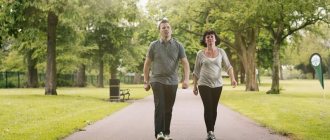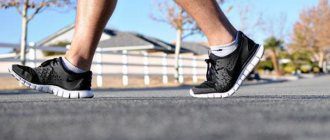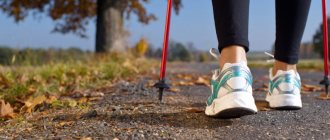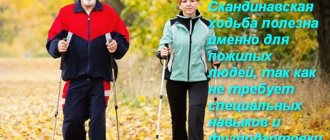Home » Useful to know » Therapeutic dosed walking path: what is it, what does it mean, route
Therapeutic walking called health path is becoming increasingly popular. But its appointment is made only by a doctor, who will take into account the patient’s age and state of health. At the same time, the duration, speed, and frequency of the training sessions are clearly defined.
What is health path walking, types
Health path is one of the varieties of therapeutic techniques. This is therapeutic walking, the path of which takes place in mountainous areas. It includes an integrated approach to health improvement, where the main place is given to therapeutic walking.
The rest of the result is achieved thanks to the action of climatotherapy, aerotherapy and landscape therapy.
Therapeutic walking technique
Therapeutic walking is practically no different from regular walking, with the exception of some nuances that are reflected in the rules of technique:
- Preparation: Choose comfortable clothes and shoes for walking. A good option would be sportswear and sneakers, as for a regular workout.
- To increase the fat burning effect, increase your walking speed from slow to moderately fast.
- Keep your back straight and your shoulders back.
- Do not restrict the movement of your hands, do not put them in your pockets.
The main elements of therapeutic walking technique: comfortable clothing, moderate pace, straight posture
How to walk correctly to achieve a healing effect: video instructions
History of development
In the 19th century Dr. Hartwig discovers the therapeutic possibilities of ordinary walking, but in areas where more energy is required from the human body than during normal movement. He described the method as a therapeutic and prophylactic remedy for diseases.
The doctor forced his patients to walk for kilometers through hilly terrain along the coast . Another doctor, Herr Werber, also promoted hiking, but only recommended taking the trails of Switzerland and Germany.
The name was coined by Dr. Max Ertel. Terrenkur from the French terran and cours. The doctor recommended that patients with cardiovascular diseases and excess weight start walking. In this case, each person has their own route .
In 1885, the first walking route for classes appeared, after which the popularity of the method began to grow. The love for the trails of resorts such as Switzerland, Germany or Austria began to be especially cultivated. Special routes are also being created in other countries where the climate is suitable for practicing health paths.
How is walking beneficial for men and women?
Natural physical activity is beneficial for adults and children of all ages. However, there are significant differences in the effects of walking on men and women:
Table: effects of walking on men and women
| The effects of walking on the body | |
| In men |
|
| Among women |
|
General benefits of walking for men and women include:
- Burning excess fat. With moderate and intense walking, the layer of subcutaneous and visceral fat decreases, which has a positive effect not only on appearance, but also on the functioning of internal organs.
- Walking saturates the blood, makes it move and renew itself much faster than with a sedentary lifestyle.
- Walking strengthens bones and joints and prevents the occurrence of diseases such as osteochondrosis, arthritis and osteoporosis.
- Light physical activity helps improve mental well-being. In this case, walking accelerates the production of dopamine and, together with tone, improves mood, normalizes the emotional state, and helps to resist stress.
- Daily walking prevents cardiovascular diseases, increases the speed of metabolic processes, and removes toxins and waste from the body.
- Intense walking helps increase endurance and strength of the body.
Daily walking is aimed at improving a person’s physical and mental well-being
About other benefits of walking
How is therapeutic walking useful, does walking provide any benefit to the body, and you can learn about the achievements of walking by watching the video:
Rules and features of the path
To engage in a health path, you should choose the right route with a picturesque area and an ever-changing landscape. These can be places where there are mountains and plains, or a seashore. The main thing is that there is no wind and the zone is an environmentally friendly place .
The load is given individually. The doctor determines how long the route should be, how many stops are needed, what climbs should be organized.
When drawing up a plan, the doctor takes into account the patient’s condition , what diseases have been suffered, the presence of excess weight, the state of a psycho-emotional nature, how hardy the person is.
The surface of the trail is also discussed individually. The patient can walk on asphalt, dirt, gravel or grass. There are benches along each trail for a short rest. In this case, the complexity of the route may increase :
- Low level. The patient must walk up to 0.5 km .
- Average. Here the length of the route is 1 km .
- The difficulty of the exercises is high. You need to walk about 2 km or more.
Each route has a certain number of stops . All of them involve walking across rough terrain. In this case, the pace is taken moderate so that the body adapts and does not waste much energy.
Be sure to alternate between active travel and rest on the road. Thus, the body tenses and relaxes internally. This alternation becomes beneficial for cardiovascular disease.
Mandatory rules:
- regularity;
- no talking to balance breathing;
- The ascent is carried out in small steps ;
- clothes and shoes should not create discomfort;
- To get a positive result, you need to maintain correct posture. Shoulders should be straightened , back straight;
- the time when the exercises are performed also plays a role, so it is worth correctly deciding at what time of day the training will be carried out - evening, morning or afternoon;
- You should not start the lesson immediately after you have eaten;
- If your head starts to hurt or you feel dizzy, you should stop training or not start if you experience any discomfort.
If at the end of the walking route there is fatigue in the body, energy surges - this can only mean that the training went correctly.
What you need for walking
Before walking and after, you need to drink a glass of water to replenish fluid loss. For a walk, you can take a bottle of warm, not hot water with you and drink during breaks. Clothing should be comfortable and not restrict movement. A tracksuit and sneakers are best for this. Shoes with heels should be excluded. You can take your player for a walk, combining business with pleasure. After class, when you come home, you can have a snack, but do not overeat. When you get into the groove and exercise becomes a habit for you, the pace can be increased. It is useful to combine walking with morning exercises.
Norm of steps per day
It is believed that to feel good, you need to take at least 10,000 steps a day - which is 6-8 km, depending on the length of the step. It is estimated that the average person takes about 3,000 steps a day, including walking at work and around the house. Therefore, in order to gain the required number of steps, you need to try hard and spend an additional hour walking a day.
True, many experts believe that only “pure” steps are taken into account here, i.e. walking around the house or running errands has nothing to do with it. If it's cold or raining outside, a treadmill can replace walking. You can not only run on it, but also walk at a fast pace. It is important to control your breathing and your condition and not forget about the mileage.
Indications and contraindications
Health path can be used not only for the treatment of diseases, but also for the prevention of many diseases . It has long been known that walking in the fresh air has a beneficial health effect, which is also beneficial for healthy people.
Indications for classes:
- sedentary and inactive lifestyle ;
- respiratory diseases . These are diseases such as asthma, bronchitis, pneumonia;
- problems with the digestive system ;
- after a heart attack, therapeutic walking is also recommended for hypertension or hypotension;
- recovery period after injury ;
- diseases of the nervous system, it successfully treats stress , neurosis;
- metabolic processes are restored thanks to constant training;
- osteochondrosis and obliterating endarteritis.
Along with the indications for use, it is necessary to talk about the reasons why a person is strictly prohibited or not recommended to engage in a health path.
Good to know! Terrenkur is successfully practiced in sanatoriums:
- “Solotcha” in the Ryazan region
- “Livadia” in Kazan
- “Mountain” in Krasnodar region
- “Kuban” in Gelendzhik
- “Peredelkino” in the Moscow region
- “Red Hill” in the Yaroslavl region
Contraindications for use:
- a disease in the acute ;
- fever;
- diseases of the organic type, at a stage when the body cannot resist disturbances;
- pain of unknown origin.
What is the benefit of walking in place? Do you need to walk a lot in the morning or can you do it in the evening?
It is very important to mention the fact that walking in place is allowed for absolutely each of us and has virtually no contraindications - this is, of course, the advantage of this activity. The only limitation may be the duration of walking - for those who, due to injuries or illnesses, are prohibited from prolonged stress on their legs.
In combination with proper nutrition, walking in place can help maintain muscle tone (especially in the lower body). This exercise also strengthens the respiratory system and maintains overall health - after all, even minor physical activity is healthier than lying on the couch.
Is it necessary to exercise in the morning? You can practice walking both in the morning and in the evening; basically, the choice of time of day for exercise is determined by the characteristics of the body and your daily routine.
In the process of walking in place, metabolism is normalized due to the release of heat and energy. As many people know, accelerated metabolism is the best assistant for losing weight.
Criteria for choosing a health path route
Routes for classes are selected exclusively by a doctor and a physical therapy methodologist. As a rule, an area with hills and no wind is chosen for this. There should be dry and clean air here. There are benches along the route where patients can sit to rest. Also along the entire route there are signs by which you can find out how much is left to the final point and at what angle the ascent will take place.
Today there are three types of routes designed for walking:
- Easy road. Its length is no more than 500 m.
- Middle route. Here a person will have to walk from 500 m to 1.5 km.
- Hard way. The length ranges from one and a half kilometers to 3 km.
There is also a difference in the pace at which the path is covered. It can be slow from 60 to 80 steps per minute , to medium (80-100) or fast (more than 100 steps).
Photo gallery:
Walking route
There are special trails for health paths in boarding houses in the cities that we talked about above. But don't despair. You can always do everything with your own hands or feet.
The route should be in an area familiar to you. It must be safe, that is, not cross deserted wastelands, places where packs of stray dogs gather, and not run along the sides of roads.
It is advisable that the route contain as little asphalt sections, concrete paved areas, and paving stones as much as possible. The fact is that walking on such surfaces greatly tires our body.
Ideally, these will be natural trails laid in the park. It’s even better if your route contains ascent and descent, and sections with sand. It is important that it is located in a “green zone” with a natural view that can be admired while walking.
Health path for children
Modern children increasingly spend time at home, sitting at the computer. As a result, lack of health, metabolic disorders. Health path is becoming an effective method in the fight against excess weight.
As a rule, a path for children takes place in places where you can see a lake and there are small mountains .
Race walking
How is this walking different from normal walking?
The whole foot should work: you need to place your heel first, then roll it onto your toe and push off harder - work with both legs equally.
Ideally, imagine your foot as a round ball that needs to be rolled along the ground - from heel to toe: this way you can burn more calories and maintain a healthy spine.
Posture should be straight: back straight, shoulders turned and lowered freely, head held so as to look forward and not at your feet; the stomach is tightened, the buttocks too.
The pace of walking is accelerated not by increasing steps: simply move your legs faster, helping yourself with your arms bent at the elbows at an angle of 90°C - no need to press them to your body.
It is necessary to reduce the pace at the end of the walk gradually so that your muscles do not hurt: slow down your step and walk slowly until your pulse returns to normal.
While walking, try to breathe through your nose.
Is it possible to drink?
You can not only drink, but also need to.
Before you go for a walk, be sure to drink a glass of water and take a small bottle with you. While walking, you can take a few sips, but under no circumstances should you become dehydrated.
Benefits and harms
When the body experiences stress, it helps it maintain health . When a person regularly goes through the routes of a health path, the following positive results can be identified:
- the body becomes more resilient ;
- the cardiovascular system returns to normal, its functioning becomes better;
- metabolic processes are stabilized;
- breathing becomes even;
- when a person moves, all the muscles in his body work ;
- walking has a beneficial effect on brain function;
- the nervous and emotional state is restored.
Health path classes are an excellent substitute for the gym. The load is comparable to aerobics. Additionally, a person is surrounded by nature, he inhales clean air.
Healthy walking. Benefits and recommendations for walking
Good day, dear subscribers! Today we will touch on the topic of what healthy walking is and talk about its benefits. And as usual, I’ll give you some practical advice.
Let's talk about simple walking first.
Regular walking is a universal means of physical activity on the body. It has virtually no contraindications; it does not require special clothing or equipment. I always recommend to my subscribers to walk more, not to use the elevator, car or public transport.
Following these recommendations will allow you to prevent the occurrence of varicose veins, cardiovascular diseases, and respiratory diseases. It will make you feel like a cheerful and confident person.
Walking is possible and even necessary at any age. This activity can be successfully combined with work by leaving 1-2 stops earlier than needed. If you are a young mother, then there are no problems at all, take a stroller with your baby, and go for a leisurely walk to the nearest park. And the child walks, and you relax! Both breathe fresh air. Many mothers with strollers simply sit on a bench, although walking is much healthier for the body and more interesting for oneself.
Remember that any walk, be it a trip to the grocery store, an evening walk in the park, to a bus stop, to your place of work, etc., has health benefits! Always think about this in your mind. Program yourself with such thoughts. And it will be easier for you to force yourself to go for a simple walk.
Healthy walking: difference from a simple walk
There is also such a thing as healthy walking. Healthy walking is somewhat different from simple walking. The difference comes in the pace, proper walking technique, walking time and distance, and the frequency of walking. That is, recreational walking is a kind of sports training.
Health walking is also divided into several types. Depending on the tempo, it can be slow, medium and fast. At the same time, recreational walking does not involve the use of special equipment. Therefore, dear subscribers, do not confuse it with “Swedish walking” (with poles).
Healthy walking (walking for health) is a natural, habitual and physiological type of physical activity for a person of any age and gender. The movements a person makes when walking are cyclical, that is, various muscles of the body alternately relax and tense, which allows one to achieve an excellent training effect.
The physical activity during healthy walking is not too intense and high, it corresponds to the optimum for each muscle of the body, which guarantees the absence of overload and associated dangers, such as injuries, excessive tension, fatigue, etc. In addition, by changing the walking speed or the terrain used for walking, you can easily increase or decrease the load, transferring it from a training mode to a gentle general strengthening one and vice versa.
Who needs healthy walking?
Health-improving walking is recommended for absolutely all categories of people, regardless of gender, age, health status, and physiological characteristics. Don’t forget that every person on the planet needs to travel at least 10 kilometers per day. Only in this case can you guarantee yourself absolute health.
Of course, if you are healthy, young and full of optimism, I recommend that you start running, go to the pool, ski and the like. But if you have any diseases, for example, the cardiovascular system, respiratory or oxygen transport, then it is better to start physical education with recreational walking. Gradually, over time, you will switch to faster workouts.
Also, healthy walking is useful for older people and for people suffering from extreme forms of obesity. Those who want to lose weight and prolong their life, make it happier and more successful, then healthy walking is just for you!
The benefits of healthy walking for the human body
Healthy walking is in many ways beneficial for the body of every person, regardless of age. Healthy walking rejuvenates, prevents the appearance of chronic age-related diseases, normalizes blood pressure, mobilizes strength, helps keep one’s strength and thoughts in good shape, and helps to lose excess weight.
Healthy walking helps to activate the entire body as a whole. Even at an average pace, the body will experience incomparable benefits.
To train endurance and improve the functioning of the cardiovascular and respiratory systems, healthy walking is more effective than various static physical activities (exercises on simulators, weight lifting, etc.). Body movements and muscle work during healthy walking accelerate blood in all organs and tissues. Due to this, the supply of oxygen and nutrients to organs and tissues increases.
In addition, healthy walking promotes weight loss. However, if you plan to lose weight, then along with physical activity, organize proper nutrition, taking into account the consumption of kilocalories per day.
Let's move on! Healthy walking improves mood and general condition of the body, and also normalizes blood pressure, prevents atherosclerosis and reduces the concentration of cholesterol in the blood. Therefore, a person who engages in recreational walking literally goes very far from heart attacks, strokes, atherosclerosis, thrombosis and other diseases of the cardiovascular system.
Thus, it is healthy walking that is the optimal training for a long and active life without the burden of chronic diseases. In terms of the effectiveness of maintaining the normal functional state of the cardiovascular system and preventing its diseases, walking literally has no equal.
The benefits of daily 30-40-minute walking for the human body are to achieve the following positive effects:
- The heart muscle is strengthened, blood flow in all organs and tissues is improved, and the amount of oxygen and nutrients delivered to them increases;
- Heart attack, stroke and vascular thromboembolism are prevented;
- Blood cholesterol levels are reduced;
- The risk of developing type II diabetes mellitus is reduced by 30–40%;
- The risk of developing breast cancer in women is reduced;
- The risk of developing prostate cancer in men is reduced by 50%;
- Reduces the risk of developing colon cancer in men and women;
- The digestion process improves and stool regularity is normalized;
- The risk of developing glaucoma is reduced;
- Intraocular pressure decreases;
- Improves mood;
- The feeling of isolation and helplessness is relieved;
- Sleep is normalized and insomnia is eliminated;
- Life expectancy and its quality increase;
- General well-being improves;
- Lung capacity and depth of breathing increases;
- Bones, joints and spine are strengthened, which reduces the risk of fractures, dislocations and other traumatic injuries to the musculoskeletal system;
- Immunity improves due to the hardening effect, as a result of which a person gets sick less often and tolerates colds and seasonal respiratory diseases more easily;
- The muscle frame is strengthened and endurance increases;
- Promotes weight loss;
- The aging process slows down;
- Normalizes healthy sleep;
- Stress is eliminated.
And these are not all the effects of healthy walking, but only the main and most significant ones. I hope now you have no doubts about whether to engage in healthy walking?! It seems to me that everything is obvious.
As noted above, there are practically no contraindications for health walking. Healthy walking can only cause harm if you neglect the safety rules: wear uncomfortable shoes or clothes, don’t take off your jewelry, or pick up the pace too quickly.
When walking very fast, there is a risk of harming your knee joints, so watch the condition of your knees. Walk calmly. If your knees start to hurt, then it is better to consult a doctor, find out the cause of the disease, and, having eliminated it, start walking again.
Health walking technique
Healthy walking should not be confused with a leisurely walk before bed or to improve appetite, since these are different types of physical activity. We will look at the technique and rules of healthy walking, since the benefits of this type of movement are very great, and all other walking options are, in fact, its varieties. In this article you will learn how to walk correctly for health.
Foot, posture, arms and torso when walking.
When walking for health, you need to keep your body in the correct position, namely: straighten your back, slightly squeeze your shoulder blades, tighten your stomach and place your head so that your chin is parallel to the floor. Then, without changing the accepted position, you should slightly move your body weight forward so that it is concentrated on the tubercles of the foot and toes.
In principle, correct distribution of body weight can be achieved in a simpler way. To do this, you need to try to stand on your toes with straight legs and, as soon as you feel that the weight has moved forward so much that you can lift your heels off the floor, you should fixate in this position, since this is the correct distribution of body weight for walking. Having assumed the required position, you should maintain it until you finish walking.
You need to walk at a good pace, vigorously moving your legs. When taking a step, you must first move the thigh of one leg forward. Immediately after this, you should simultaneously straighten the knee of the same leg, and with the second leg behind the body, push off from the ground, rising onto your toes.
After the push, the leg that is in front must be straightened and placed with the heel on the ground so that the toe is raised up. The leg that is behind is completely straightened and placed on the toe. At this moment, the body weight is concentrated between two legs, that is, a person cannot lift either of them without first moving the center of gravity.
From this position, the body weight is transferred to the leg in front. To do this, the foot of the front leg is quickly lowered to the ground, resting on the tubercles of the toes and its outer surface. At the same time, the leg remains straight. The leg remaining behind is bent at the knee and its thigh is brought forward for the next step. After releasing the hips, straighten the leg at the knee and, at the same time pushing off with the second leg, lower it with the heel to the ground, etc.
Thanks to the push of the leg behind, the step turns out to be long, elastic and springy. When walking, the foot works as if constantly rolling from heel to toe.
You cannot place the entire foot of the walking leg (located in front) on the ground at once; you must first lean on the heel and only then transfer the body weight to the tubercles of the toes.
The foot of the rear leg, before the support of the front leg on the heel, is raised onto the toe, and in this position it gives a push to the body in the forward direction in order to push the front leg as far as possible. And only when the front leg rests on the ground with the heel, the entire weight of the body begins to be transferred to it, for which the foot gradually lowers completely to the ground. And at the moment when the foot of the front leg is completely on the ground, the foot of the rear leg, which was in a position on its toes, lifts off the floor and the hips begin to move forward to perform the next step.
When walking, you should try to place the heels of your feet on one imaginary line passing between your legs (as models do when walking along the catwalk at fashion shows). In this case, it is necessary to turn the socks outward a little, but if this does not work, then it is quite possible to clubfoot, since this will not negatively affect walking.
During healthy walking, you should not relax your knees; you should always fully straighten the pushing leg, which ends up behind the body during the next step. During health walking, it is better to bend your arms at the elbows and move them in the opposite direction with your legs (that is, when the right leg is in front, the left arm corresponds to it, etc.).
You should look forward, not at your feet, and your face should remain relaxed, not tense, during healthy walking. The torso, legs and shoulders should be toned, but not the face and hands. You should not try to lengthen your stride by trying to place the foot in front as far as possible. This walking technique is incorrect and dangerous.
Breathing while walking. How to breathe when walking
It is also important to monitor your breathing while walking. When walking, you need to breathe rhythmically, at the same pace as walking. If the air is dirty, there is a lot of dust, or the weather is frosty or windy, then you should inhale through your nose and exhale through your mouth. And so, in principle, there are no specific recommendations regarding breathing. You can breathe through your nose or mouth. But it’s better, of course, to try to breathe through your nose, since the pace of movement during healthy walking is not high compared to running.
Correct breathing will require quite a lot of effort at first, but after a while you will get used to a certain way of breathing and the rhythm of inhalation and exhalation, which will allow you to no longer control this process.
However, at the beginning of training, you should strictly control that when walking on level ground, inhalation lasts 4–5 steps, and exhalation lasts 5–6 steps. If a person climbs a mountain, then it is necessary that the inhalation be longer than the exhalation, and when descending, on the contrary, the exhalation must be longer than the inhalation.
There should be no shortness of breath during healthy walking. If shortness of breath appears, then the pace of walking should be reduced. It is better to walk at a slower pace for several days or weeks, training your endurance so that you can move much faster in the future, rather than suffer serious complications from the first sessions.
The optimal breathing rhythm is such that a person should be able to speak while moving, but could not sing. Accordingly, if a person cannot speak while walking, then the pace and speed of movement should be reduced, and if he can sing, then, on the contrary, it is necessary to increase the pace.
How much time and kilometers should you walk per day?
Healthy walking will be healthy only if you walk a certain number of kilometers per day, week and month. To do this, you need to count.
So, how much time and how far a day do you need to walk for health walking to bring health benefits? For a healthy person who wants to stay fit and improve their health, I recommend walking every day, leaving only one or two days a week for rest.
Depending on your physical fitness, endurance and your health, you need to walk 5 to 10 km daily, or every other day. I also recommend using rough terrain when walking, alternating descents, ascents and flat surfaces.
People with cardiovascular diseases are advised to start walking on level ground, gradually increasing the distance, walking speed and adding uphill and downhill movement.
It is better for healthy people to walk quickly, with the main emphasis on the pace of movement, while weakened people and those suffering from chronic diseases, on the contrary, are recommended to walk relatively slowly, with the main emphasis on distance.
According to speed, walking is divided into the following types: Very slow - 60 - 70 steps per minute; Slow – 70 – 90 steps per minute; Medium – 90 – 120 steps per minute; Fast – 120 – 140 steps per minute; Very fast - more than 140 steps per minute.
If a person is over 35 years old and has never exercised before, he should start with very slow walking. If a person over 35 years of age is in good physical shape or very slow walking seems too easy to him, then he should start slow.
People under 35 are also advised to start with slow walking. In the first week, you should walk for half an hour at the chosen pace. Then every two weeks you need to increase your walking time by 5 minutes, and your pace by 5 steps per minute, thereby lengthening the distance walked.
Remember that any weather is suitable for healthy walking. You just need to dress according to the air temperature, humidity and wind speed. It is optimal to walk 1 hour before meals or 1.5 - 2 hours after meals. However, it is necessary to select the time for walking so that the walk ends 2-3 hours before going to bed. If you exercise regularly, you should go at different times of the day.
That's all, dear followers of sports and a healthy lifestyle! Walk more often. Engage in physical education, and if you are young, then feel free to play sports. And never get sick! And how to achieve this, you can find out on the blog pages! Good luck to you in your endeavors!
If you found this article helpful, please share it with your friends!
Patient reviews
Olga. We rested in the Anapa sanatorium with colleagues. The health path was 7900 m long. Such a walk gave a good load on the body. Moreover, the road was not boring. There was always something along the way. I highly recommend Anapa and a walk along the coast.
Marina. In order for walking to be beneficial, you need to start with flat terrain, and only then move on to mountains, hills and slopes. At the same time, you can walk in the rain and in the heat. The sanatoriums of Kislovodsk offer therapeutic walking for patients with cardiovascular pathologies.
Svetlana. I came across the health path by accident. While walking around the sanatorium I saw a rusty sign. This is how my acquaintance with therapeutic walking began. True, I only went 2 times. The first time I reached the 2500 m mark, and the second time I reached 3500 m. I didn’t dare go further, the air was different and it was hard to breathe. But I decided that I would continue training and perhaps reach the final point of the route.
Watch the video - what is therapeutic dosed walking on a health path:
Walking pace
The term " walking pace " refers to the number of steps you take per unit of time. This parameter can be controlled in the simplest ways - using the second hand of a watch or a cell phone timer with counting steps over a certain period of time. Typically this time period is taken to be one minute. It's easier to count this way.
Another way to control your walking pace is to use a special pedometer, which will automatically calculate how many steps you have taken in a specific period of time.
Pedometers are miniature electronic or mechanical step counters, secured with a special strap on a shoe or directly on the foot. Whichever method of control is more accessible and appealing to you, use it.
The load on the body is considered to be the walking pace and the time spent walking a certain distance at a given pace. The reaction of your body is characterized by subjective and objective indicators.
A subjective indicator is how you feel during the movement and after the distance covered. The absence of dizziness, unnatural pallor, pain in the joints and heart will tell you that the load you have chosen is within your capabilities. How to optimize the load when walking - more on that a little later.
Walking is a slow run
It even sounds a little funny, but if you let the experts at health.harvard.edu think logically: the effect of physical exercise depends on three components - intensity, duration and overall frequency of exercise.
To put it very roughly: you can quickly push yourself while running, or do the same work calmly and thoughtfully, covering the same distance over a longer period of time - the load will be approximately the same, but the time spent will be different. By the way, there is an opinion that the key thing in the load is the total work done, and not the intensity with which you did it. There is a grain in this, but not everything is so simple, of course.
The reputable American Heart Association and American College of Sports Medicine recommend walking at least 30 minutes a day and at least 5 days a week. The minimum recommendations from the same organizations for running: 20 minutes a day, 3 days a week.
From the point of view of load efficiency, in a minute of time the runner overtakes the walker, but firstly, it is not clear whether there is any point in rushing, and secondly, slowing down clearly has its advantages and if you think about it, there are quite a lot of them, starting from the fact that there is no need to change sweaty T-shirt and ending with a much lower risk of injuries, including cumulative ones.
Types of walking
Depending on the pace, speed, distance traveled and devices used, the following types of walking are distinguished:
- wellness;
- Scandinavian;
- fast;
- kinds of sports;
- walking for weight loss.
Healthy walking
This type of walking is an accessible type of physical activity for every person, aimed at overall strengthening of the body. Depending on the intensity of the load, walking can be slow, medium, fast and very fast.
Everyone can choose the best option for themselves, depending on age, general condition of the body and physical fitness.
Nordic walking
Nordic walking is a variation of walking with poles in your hands. The man steps with his feet and at the same time pushes off the ground with sticks in his hands. The presence of sticks forces, firstly, to increase the length of steps, and secondly, it involves the upper body in intense work, which creates physical activity.
When Nordic walking, 90% of all muscles are involved, which increases the load, increases the number of calories burned and allows you to use all muscle groups in the workout. In addition, holding the sticks in your hands prevents you from hitting your knees and back, which minimizes unnecessary stress on your joints.
Nordic walking poles are lightweight and durable because they are made from a mixture of fiberglass and carbon fiber. The length of the sticks is calculated individually using the formula: human height * 0.68.
Power walking
Power walking is a combination of different body and arm movements while walking. Movements of the body and hands are made consciously, since with their help the flow of energies is initiated in accordance with traditional Eastern medical and recreational practices.
By activating the circulation of energy through the channels, healing and restoration of balance throughout the body occur. Power walking can be practiced without any equipment or with poles in your hands, but not those used for Nordic walking.
Race walking
Walking is a fast movement without jogging. In principle, the main thing in race walking is to move at maximum speed without switching to running. The speed of such a walk is 2-3 times faster than that of a wellness walk due to the length and high frequency of steps. Sports doctors believe that this walking option is more beneficial than running because a person gets less tired and there is no strong pressure on the joints and spine.
A characteristic feature of race walking is that the supporting leg remains straight from the moment it touches the ground until the body weight is transferred through this point. To accomplish this, a person works intensively with his hands, shaking his body and pelvis. Unlike jogging, there is no flight phase when both feet are off the ground.
Not everyone can walk. If you have flat feet, you cannot do this type of walking because your body weight is not distributed correctly on your feet, which can lead to injury.
Walking for weight loss
Walking for weight loss, in fact, is a quick health option, the effect of which is aimed at reducing hours. However, you should remember that to achieve results you need to walk, firstly, move quickly, and secondly, cover quite a long distance - take at least 10,000 steps a day.
Benefits of walking up stairs
Cardiologists tell their patients that they are physically fit enough for sex if climbing 2-3 floors of stairs does not cause any problems.
Researchers from Canada monitored 17 subjects with an average age of 64 years during normal walking, strength training and climbing stairs. It turned out that walking up stairs is the most energy-intensive activity - about 50% more expensive than regular strength training. So walking up the stairs is a powerful load that should not be neglected. Be happy if you live on a high floor (and if there is no elevator there yet, then this is just a gift to your health).
The Harvard study also found that people who averaged at least 8 floors per day were 33% less likely to die than those who climbed almost no stairs.
By the way, Zozhnik has a whole great article about the benefits of walking on steps with interesting scientific calculations.
Why walking is better than running: less impact, fewer injuries
It is clear that if you are in a hurry (to catch an antelope with a spear, for example), then running is obviously preferable to walking.
But the difference between these two activities is not only speed. During walking, at least one foot is in contact with the ground at any given time. While running, the runner spends part of the time in flight. And the higher the speed, the more time the runner spends in the air, without contact with the surface. Elite runners spend up to 45% of their time “flying.”
But what takes off must also fall if it is not in Earth's orbit. During landing, runners subject their bodies to a stress equivalent to approximately three times their own body weight. Over the course of a brisk mile of running, a typical runner's legs absorb about 100 tons of impact forces. In this regard, running can both strengthen the body and harm (everything, of course, depends on many conditions and, above all, each individual person – Zozhnik’s note).
Ultimately, the risk of ever suffering an exercise-related injury while walking is very low (1 to 5%), but while running it is high (20 to 70%).
What you need to start walking
To start walking, you need several things.
Here is the list:
- Walking shoes.
- Comfortable clothes.
- A bottle of water and an energy bar for long walks.
- If you decide to walk to the office, wear office clothes and a pair of comfortable shoes that you can change into at work.
- Raincoat.
- Motivation is necessary at least in the first 5 days.
How to Stay Motivated to Walk
- Ask a friend to join.
- Walk your dog in the morning or evening.
- Go for a walk with family or friends in the evening, or after dinner.
- Walk to the nearest store or cafe.
- Think about how much money you can save by walking.
- Use the planner to determine the best walking route, measure heart pressure, calories burned, use a pedometer, etc.
- Explore different routes every day.
- Join a walking group.
- Go on a hike.
- Come to social events.
What muscles are used when walking?
- During a typical walk, more than 200 muscles are involved in the movement - the legs, buttocks, thighs, as well as the back and lower abdomen.
- During Nordic walking, the muscles of the arms and shoulder girdle are additionally involved in the work.
- When walking uphill on a flat surface, the load on the abdominal muscles, calves, thighs, and buttocks increases.










